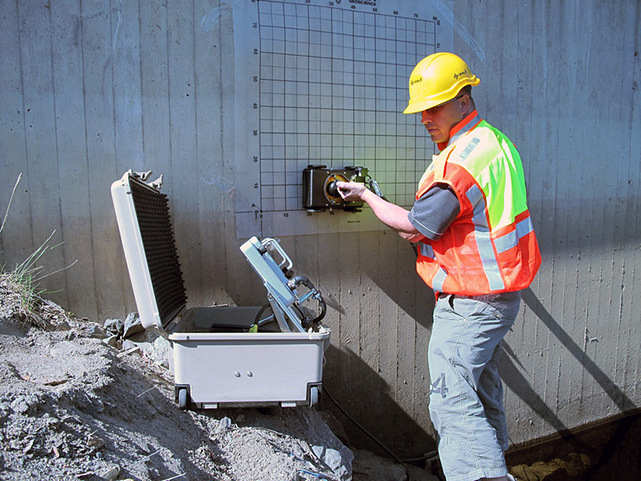Thorough Insights into Concrete Scanning Procedures
Thorough Insights into Concrete Scanning Procedures
Blog Article
Past the Surface Area: Leveraging Advanced Concrete Scanning Techniques for Unmatched Accuracy and Insight
In the world of building and construction and facilities maintenance, the quest for accuracy and thoroughness is never-ending. Advanced concrete scanning strategies have emerged as essential devices in this quest, using a look underneath the surface area to introduce a globe of important understandings. By harnessing innovative technologies, experts can uncover abnormalities, evaluate the condition of concrete frameworks, and make notified decisions that shape the course of tasks. The ramifications of these strategies expand far past simple surface-level examinations, promising a deepness of precision and understanding that is unparalleled.
Significance of Advanced Concrete Scanning
The relevance of utilizing sophisticated concrete scanning strategies depends on the unequaled accuracy they offer for finding sub-surface abnormalities and guaranteeing structural honesty. By employing advanced innovations such as ground-penetrating radar (GPR), electro-magnetic induction, and progressed finder imaging, building and construction professionals can dig underneath the surface area of concrete frameworks with a degree of accuracy that far goes beyond typical evaluation techniques. Concrete Scanning. These strategies enable the identification of covert threats like rebar corrosion, spaces, channels, or post-tension cable televisions that can compromise the stability and safety and security of a framework gradually
In addition, advanced concrete scanning supplies important insights right into the general condition of a concrete component without the need for intrusive steps, reducing the risk of causing damages during the assessment procedure. The capacity to identify the precise place and deepness of prospective issues permits for targeted fixings and maintenance, ultimately lengthening the life expectancy of the structure and maximizing its performance. Essentially, the relevance of sophisticated concrete scanning can not be overstated in the world of building and infrastructure upkeep, where precision and integrity are paramount.
Kinds of Cutting-Edge Technologies

Anomalies and Flaw Discovery

Along with GPR, concrete scanning techniques like thermography and impact-echo testing are likewise reliable in finding issues and abnormalities. Thermography makes use of infrared technology to identify variations in surface temperature, suggesting prospective locations of worry such as delamination or dampness access. On the various other hand, impact-echo testing includes examining acoustic feedbacks to detect voids, cracks, and other issues within the concrete. By leveraging these advanced techniques, professionals can proactively address structural issues, ensuring the longevity and safety of concrete frameworks.
Assessing Concrete Condition
How can engineers properly examine the problem of concrete frameworks to guarantee their long life and safety and security? Examining the concrete problem is a critical facet of preserving framework stability. Different advanced concrete scanning strategies are utilized for this objective. Ground-penetrating radar (GPR) is frequently utilized to assess the inner structure of concrete, detecting gaps, click here to read fractures, and various other abnormalities that may endanger its toughness. Furthermore, impact-echo testing can give understandings right into the density and stability of concrete elements. Ultrasonic pulse rate screening is another useful method for reviewing concrete quality by gauging the speed of sound waves via the material.
Additionally, aesthetic examination remains an essential component of concrete problem assessment. Engineers visually analyze the surface area for indicators of wear and tear, such as spalling, fracturing, or staining. Incorporating non-destructive screening methods with aesthetic examinations enables an extensive examination of concrete condition, allowing engineers to determine prospective problems early and apply prompt upkeep or repair services. By leveraging these sophisticated methods, engineers can ensure the long-term resilience and safety of concrete structures.
Enhancing Decision-Making Procedures
In the realm of infrastructure monitoring, enhancing decision-making processes is crucial for guaranteeing the effective upkeep and durability of concrete frameworks. Improved decision-making processes in concrete management entail using advanced scanning methods to gather thorough data on the condition of structures. By leveraging innovations such as ground-penetrating radar and 3D imaging, stakeholders can make informed choices regarding repair service, see post support, or replacement methods.
These progressed scanning strategies offer very useful insights into the interior composition of concrete, determining prospective concerns such as spaces, cracks, or rust that may not show up on the surface area. This degree of in-depth information enables aggressive upkeep planning, minimizing the danger of structural failings and enhancing the general life expectancy of concrete frameworks.
Additionally, by incorporating electronic documents and analysis devices into the decision-making procedure, stakeholders can track the evolution of concrete problems gradually, enabling anticipating maintenance strategies and enhancing resource appropriation. Eventually, the integration of sophisticated concrete scanning techniques boosts decision-making processes by giving unrivaled precision, insight, and performance in facilities management.
Final Thought
To conclude, advanced concrete scanning strategies provide exceptional precision and insight in finding anomalies, flaws, and assessing the problem look what i found of concrete frameworks. By leveraging advanced innovations, decision-making processes can be improved, bring about more educated and reliable options for maintaining and repairing concrete framework. These techniques play a vital duty in guaranteeing the safety and security and longevity of concrete structures, making them an important device in the field of building and construction and engineering.
Additionally, advanced concrete scanning gives indispensable insights into the general problem of a concrete component without the requirement for intrusive actions, reducing the risk of triggering damages during the analysis process - Concrete Scanning. Another cutting-edge modern technology is 3D X-ray scanning, which supplies thorough pictures of the internal framework of concrete, providing valuable details without the demand for harmful testing. Furthermore, Concrete Cover Meters are made use of to measure the density of concrete cover over support bars accurately. Boosted decision-making processes in concrete monitoring entail making use of advanced scanning methods to gather detailed data on the condition of frameworks.In verdict, advanced concrete scanning methods use unmatched precision and understanding in finding abnormalities, flaws, and examining the condition of concrete structures
Report this page